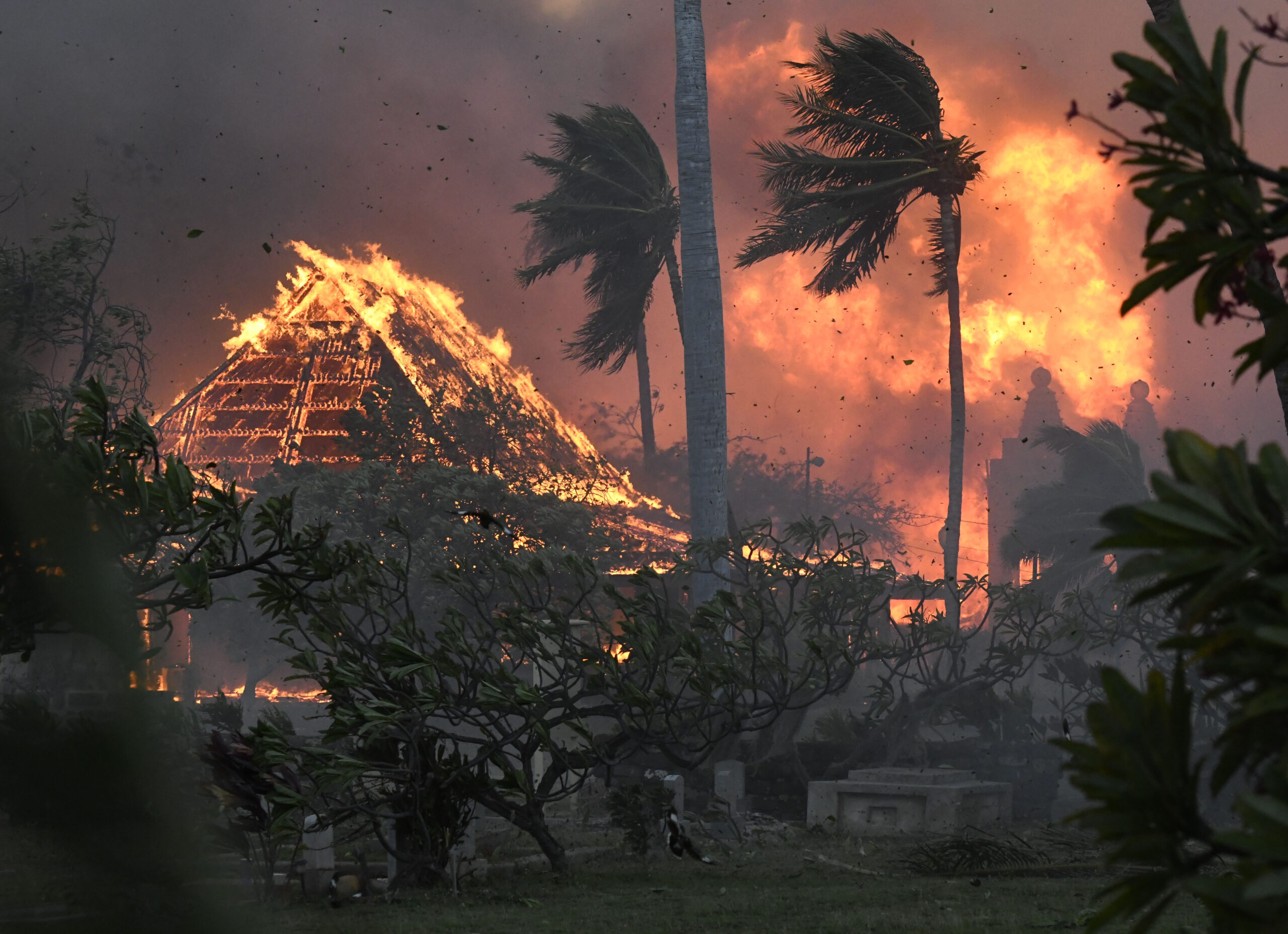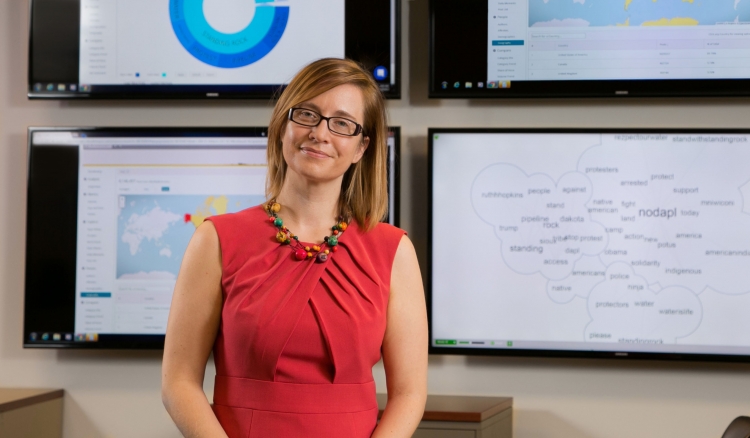
The hall of historic Waiola Church in Lahaina and nearby Lahaina Hongwanji Mission are engulfed in flames along Wainee Street on Tuesday, Aug. 8, 2023, in Lahaina, Hawaii
Disruptive and deadly weather extremes have been happening globally at an unprecedented pace, giving rise in recent months to the devastating fires on the Hawaiian island of Maui described as a “total inferno,” flash flooding in the Northeast and Midwest, deadly heat records, and relentless smoke intermittently blanketing large swathes of the country from Canadian wildfires. This year is on track to be the hottest ever.
The sheer scale of weather extremes happening all over, all at once, and the human suffering as a result is mind-boggling and frankly terrifying. It can be difficult for people to comprehend the cascading and compounding effects of the planet’s rapidly changing climate, even in the face of direct experience.
These weather extremes and the resulting tragedies present a challenge to the journalism profession to better explain what is happening and how climate change is accelerating these disasters in both frequency and scale. Newsrooms are adapting their coverage accordingly. Several have been using breaking news live updates in their extreme heat, wildfire, and flooding coverage, including the AP, BBC, CNN, The Guardian, The Times (U.K.), USA Today, and The New York Times. Yet, we do not know how news audiences are responding to this format of climate coverage. Past research does suggest that audiences have flatter emotional responses to tragedies that are perceived as distant, particularly when presented in the traditional news story format.
As a climate media scholar, I worry that this coverage may be counterproductive if the goal is moving people towards collective and individual actions that reduce carbon pollution. A sizable minority of people avoid climate change news, often because they have a negative emotional reaction, feel that there is nothing new in the storylines, or think that there is little they can do. Breaking news live blog reporting communicates the urgency of an unfolding catastrophe while public attention is at its height but does not necessarily explain what we can do about the underlying causes.
There’s also a disconnect between widespread concern about climate change and the less common perception of personally having experienced its impacts. Public opinion research published by the Yale Program on Climate Change Communication in June indicates that less than half of U.S. adults (44 percent) feel they have personally experienced climate change, despite about two-thirds being worried about it. This is a problem because recognizing the impact of climate change in one’s own life and community — along with feeling distressed about it — can be a catalyst for individual action and support for energy transition. This is also a failure of climate journalism in recent years because people are still not hearing nearly enough storytelling about localized impacts to understand that climate change is, in fact, affecting them too.
In my ongoing research into how newsrooms report on climate change in extreme heat coverage, I read a lot of weather disaster reporting. I have come to the conclusion that increasing the frequency of climate change mentions is necessary but not sufficient. It is not enough to state that climate change is setting the stage for weather disasters and making them worse when they do happen.
Audiences need to feel empowered to believe they can do something in response. News reporting needs to explain why extreme weather events are happening with increased frequency, why this matters, and, most importantly, what individuals and communities can do not only to prepare for more intense weather but also to reduce reliance on fossil fuels.
Breaking down the wall between reporter and audience, like the July 11 New York Times “Climate Forward” newsletter, can be a powerful way to present that narrative to audiences. Journalists are not removed from the climate chaos they are reporting on after all. Here is what the author, David Gelles, did well: He led with a personal story about the impact of flooding on his family and painted a clear mental picture: “I was with my family at our 100-year-old cabin in the Hudson Valley, north of New York City. It had been pouring for 14 hours, and our ceiling started leaking. Then, around midnight, a wall of water flooded the house.”
He then explained how the event was affecting his community and went on to make it significant for readers outside of the region by connecting it to the country’s lack of preparedness for flash flooding. He discussed the science in clear, jargon-free language: “We know that man-made climate change is making extreme weather like this more severe. Warmer temperatures enable air to hold more moisture, which leads to more intense rainfall and flooding.”
He went on to link this specific extreme weather event to national and international extreme weather patterns happening simultaneously, as well as explain the impact of the El Niño system in the Pacific Ocean on global temperatures and the bigger-picture challenges of rapidly deploying renewable energy technologies.
A formula for this type of story is: Lead with a personal story and human impact, zoom out to community, national, and/or international significance, explain the underlying scientific mechanisms with expert interviews or peer-reviewed research, and, crucially, use trained judgment to evaluate specific, actionable, and currently available climate solutions. Lastly, invite your audience into the story like Gelles does by asking readers to “tell us what’s got you worried, what’s giving you hope and where we should be looking for the next big story.”
This article spoke to me personally because on July 2 my family came home from a July 4 parade to a flooded basement, an experience we shared with thousands of other Chicago households. Parts of the Chicago area saw up to nine inches of rain in a single day during the record-breaking storm. For context, the city sees 3.7 inches of rain during the entire month of July on average. Climate change is making intense rain storms like this one more common in Northeastern Illinois and increasing the risks for urban flooding as a result. The city’s concrete does not leave many places for the water to go, and the sewer system was not designed to handle such a huge volume of rainfall in a matter of hours. This leaves homes vulnerable to flooding — a danger especially for people living in Cook County’s more than 24,000 basement apartment units.
Explanatory journalism like this can help break through the news fatigue by digging into the whys and hows of climate change-supercharged extreme weather events. Done well, this type of reportage can reinforce the linkages between individuals’ personal experience of weather extremes and explore the tradeoffs in what can, and must, be done to abate the worst impacts of climate change now and in the coming decades.
We have a moral imperative to make sense of extreme weather disasters, to investigate solutions, and to report back on what works as communities struggle to adapt to our hotter world for the public. Journalists need to continue to hold polluters, along with politicians and other power brokers, accountable for the decades of delay and political impasse that contributed to the devastation we are living with today as result of carbon pollution. Connecting our own experiences with climate change to the news can be the first step in making these stories more accessible to our audiences.


